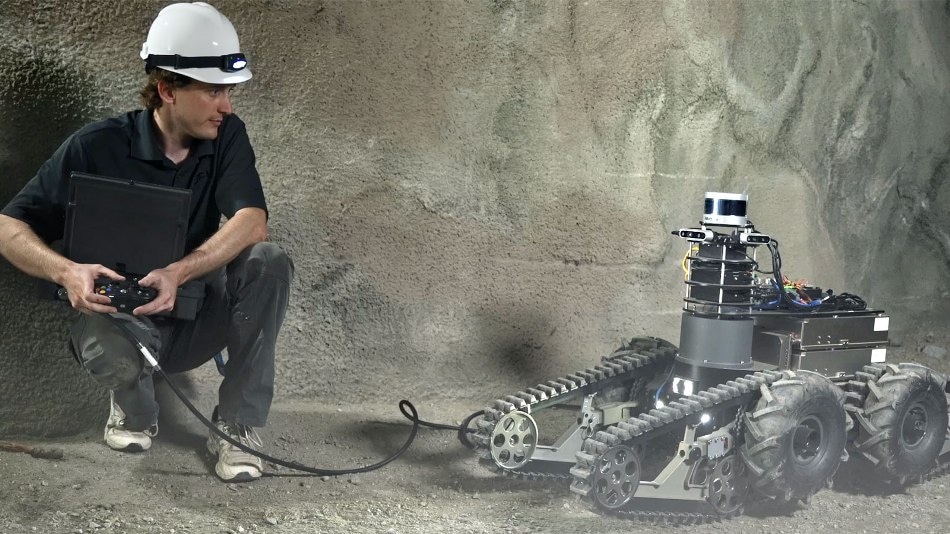Aug 14 2019
The DARPA Subterranean Challenge Systems Competition will feature robots from all over the world competing to locate objects. The event will be held on August 15th–22nd, 2019 in mining tunnels under Pittsburgh.
 JPL and its university partners are competing in the Defense Advanced Research Projects Agency's Subterranean Challenge in Pittsburgh August 15th to 22nd, 2019, with a fleet of robots built to search tunnels, caves, and other subterranean environments. (Image credit: NASA/JPL-Caltech)
JPL and its university partners are competing in the Defense Advanced Research Projects Agency's Subterranean Challenge in Pittsburgh August 15th to 22nd, 2019, with a fleet of robots built to search tunnels, caves, and other subterranean environments. (Image credit: NASA/JPL-Caltech)
NASA’s Jet Propulsion Laboratory in Pasadena, California, will head a fleet that features climbing robots, drones, and wheeled rovers that can scale obstacles by climbing on pinball-flipper-shaped treads.
The competition, conducted by the Defense Advanced Research Projects Agency (DARPA), is meant to advance technology for the military and first responders to map, steer, and look underground.
Nevertheless, technology designed for the competition will also lay the groundwork for upcoming NASA missions to lava tubes and caves existing on other planets.
“By investing in this competition, we are investing in our future,” stated Leon Alkalai, manager of the JPL Office of Strategic Planning. “There’s no doubt that the next grand challenge for JPL and for NASA is to do more subsurface exploration.”
JPL has teamed up with MIT, Caltech¸ and KAIST (formerly the Korea Advanced Institute of Science and Technology) to develop the Collaborative SubTerranean Autonomous Resilient Robots Systems team, or CoSTAR for short.
CoSTAR is one among the 11 teams that will take part in previously operational mines controlled by the National Institute for Occupational Safety and Health Mining Program.
Since the mining tunnels have a difficult terrain, the 60-member CoSTAR team has opted to utilize a number of unique robots rather than one. The team will work together to navigate utilizing artificial intelligence, map the underground passages, and detect objects like heated mannequins or cellphones concealed within the course.
The tunnels are restricted to humans; the fleet that utilizes its robots to autonomously map the most number of objects to within 5 m (approximately 16’) of their location will be declared the winner of the Tunnel Circuit, which represents the first of four stages.
This Tunnel Circuit will be followed by three more events—the Urban Circuit which will be held in February 2020, then the Cave Circuit in August 2020, and finally the Systems Final in August 2021. According to DARPA, teams contending in the final event will get a chance to win around $2 million in funding.
Tank-like tracked robots and wheeled rovers taking part in the Tunnel Circuit will cover the ground, while flying drones will locate objects that are out of reach. CoSTAR’s Drivocopter is capable of doing both—that is, driving over a complex terrain and flying through ceiling openings and along cave walls. Conversely, it will not be utilized to detect and map objects until the Urban Circuit.
JPL teams have taken part in earlier DARPA competitions, most recently with a disaster-relief robot called Robosimian. This robot is currently being adapted to investigate icy moons.
The robot resembling like an ape won the fifth place in the 2015 DARPA challenge. This event tested contestants on the potential to open a door, drive a vehicle, and drill through drywall. However, the main goal of JPL is not to win the DARPA challenge.
The big question for NASA is: Is there life beyond Earth? One of the main places to find answers to that question is subsurface environments because they are some of the most pristine locations, shielded from ultraviolet radiation and cosmic rays. If there is life in the solar system, these are the most likely places to harbor it.
Ali Agha, Principal Investigator, CoSTAR
Next Generation Robots: Autonomous Subsurface Explorers
Robots to the rescue? A sneak peek at a new generation of robots that can autonomously explore caves, pits, tunnels, and other subsurface terrains. (Video credit: NASA/JPL-Caltech)